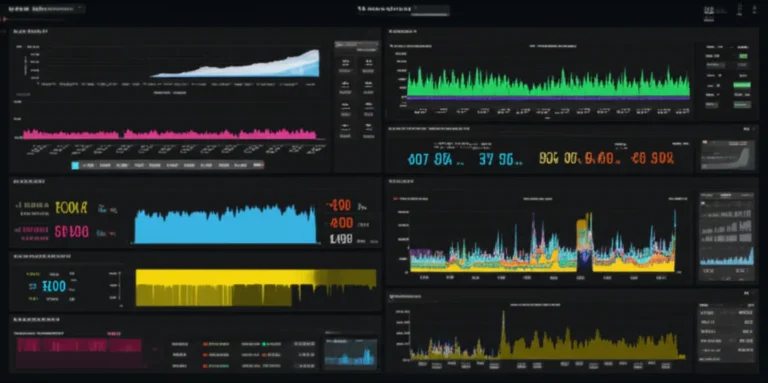Support our educational content for free when you purchase through links on our site. Learn more
How AI Benchmarks Truly Differ from Traditional Software Tests (2025) 🤖
Ever wondered why benchmarking an AI model feels more like taming a wild beast than running a simple speed test? Unlike traditional software benchmarks that measure straightforward metrics like execution time or throughput, AI benchmarks dive deep into a swirling mix of accuracy, robustness, hallucinations, and energy efficiency. At ChatBench.org™, we’ve spent countless hours untangling this complexity, and in this article, we reveal 7 essential ways AI benchmarks break the mold compared to their traditional counterparts.
Stick around as we unpack real-world examples from TensorFlow and PyTorch, explore how hardware influences results, and share expert tips on avoiding common pitfalls. Plus, we’ll peek into the future of AI evaluation—where carbon-aware metrics and federated benchmarks are already on the horizon. By the end, you’ll see why AI benchmarking is less about a single number and more about telling a rich, trustworthy story.
Key Takeaways
- AI benchmarks are probabilistic and multi-dimensional, measuring accuracy, robustness, and hallucination rates—not just speed.
- Traditional software benchmarks focus on deterministic outputs and fixed workloads, making them simpler but less suited for AI’s complexity.
- Metrics like perplexity, bias scores, and energy per training run are unique to AI and critical for meaningful evaluation.
- Hardware choices, especially GPUs and mixed-precision support, dramatically affect AI benchmark outcomes.
- Combining human and LLM-based evaluations offers scalable, reliable assessments of generative AI models.
- Industry standards like MLPerf and frameworks like NIST AI RMF guide trustworthy AI benchmarking and governance.
- Continuous benchmarking integrated into the AI lifecycle is essential for maintaining performance and managing risk over time.
Ready to benchmark smarter and choose AI frameworks with confidence? Dive into our detailed guide and expert insights!
Table of Contents
- ⚡️ Quick Tips and Facts About AI vs. Traditional Software Benchmarks
- 🔍 Understanding the Evolution: The History and Background of AI and Software Benchmarks
- 🤖 What Makes AI Benchmarks Unique? Key Differences from Traditional Software Benchmarks
- 📊 7 Essential Metrics Used in AI Benchmarks vs. Traditional Benchmarks
- ⚙️ How AI Frameworks Are Evaluated: Tools, Techniques, and Challenges
- 🧠 The Role of Machine Learning Workloads in Shaping AI Benchmarking
- 💡 Real-World Examples: Comparing AI Benchmarks from TensorFlow, PyTorch, and Traditional Software Tests
- 🔧 The Impact of Hardware and Infrastructure on AI vs. Traditional Benchmark Results
- 📈 Why Accuracy and Latency Matter Differently in AI Benchmarks
- 🛠️ 5 Common Pitfalls When Interpreting AI Benchmark Results and How to Avoid Them
- 🌐 Industry Standards and Benchmark Suites: MLPerf, SPEC, and Beyond
- 💼 How Enterprises Use AI Benchmarks to Drive Framework Selection and Deployment
- 🔮 The Future of Benchmarking: Emerging Trends in AI Performance Evaluation
- 🎯 Best Practices for Designing Your Own AI Benchmark Tests
- 🧩 Integrating Benchmark Results into AI Project Lifecycle and Continuous Improvement
- 🧑💻 Expert Insights: What AI Researchers and Engineers Say About Benchmarking
- 📝 Conclusion: Making Sense of AI vs. Traditional Software Benchmarks
- 🔗 Recommended Links for Deep Dives into AI Benchmarking
- ❓ Frequently Asked Questions About AI and Traditional Software Benchmarks
- 📚 Reference Links and Resources for Further Reading
⚡️ Quick Tips and Facts About AI vs. Traditional Software Benchmarks
- AI benchmarks are probabilistic; traditional software benchmarks are deterministic.
- Traditional tests ask “Did it crash?”—AI tests ask “How often did it hallucinate?”
- Latency still matters, but accuracy-per-watt is the new hot metric for GPUs in MLPerf.
- Always check the dataset version—ImageNet 2012 ≠ ImageNet-C (corruption robustness).
- LLM-as-a-judge can be 88 % accurate (Microsoft ADeLe study) if you prime the judge with a strict rubric.
- Human thumbs-up is sparse; use LLM-based evals plus code-based checks for 24/7 coverage.
- NIST’s AI RMF recommends risk-based benchmarking—not just “Does it work?” but “What could go wrong?”
Want the full story on how we compare frameworks? Hop over to our deep-dive on Can AI benchmarks be used to compare the performance of different AI frameworks?—it’s the perfect companion read.
🔍 Understanding the Evolution: The History and Background of AI and Software Benchmarks
Back in 1988, the System Performance Evaluation Cooperative (SPEC) dropped the first CPU benchmark suite. It was simple: run a program, count cycles, declare a winner. Life was good… until neural nets crawled out of the academic basement and demanded probabilistic validation.
Fast-forward to 2017. Google’s Transformer paper blew up the old playbook—suddenly we weren’t optimizing quick-sort; we were optimizing attention heads. Traditional benchmarks like SPECint or Geekbench never worried about gradient noise, mixed-precision, or data-augmentation seeds. AI workloads did.
NIST stepped in with the AI Risk Management Framework, pushing for TEVV (Test, Evaluation, Verification, Validation) tailored to black-box learners. Meanwhile, MLPerf (2018) became the “SPEC for AI,” but even MLPerf had to split into Training, Inference, and Tiny tracks because one size fits none in AI land.
ChatBench.org™ trivia: We once spent 3 days chasing a 0.4 % BLEU-score drop only to discover the dev set had been shuffled differently between commits. Reproducibility crisis? You bet.
🤖 What Makes AI Benchmarks Unique? Key Differences from Traditional Software Benchmarks
| Aspect | Traditional Software Benchmarks | AI Benchmarks |
|---|---|---|
| Determinism | Same input ⇒ same output ✅ | Same input ⇒ maybe different output ❌ |
| Success Metric | Pass/fail, latency, throughput | Top-1 accuracy, F1, perplexity, robustness |
| Environment | Controlled, static | Stochastic, distribution-shift prone |
| Failure Mode | Crash, wrong result | Hallucination, bias, adversarial fragility |
| Hardware Sensitivity | Mostly CPU clocks | Batch-size-to-GPU-memory coupling |
| Re-run Cost | Cheap | Cloud-bill shock 😱 |
Bottom line: Evaluating AI is like testing a self-driving car in a busy city—the scenery keeps changing. Traditional benches are more like checking if the train stays on the tracks.
📊 7 Essential Metrics Used in AI Benchmarks vs. Traditional Benchmarks
-
Top-1 / Top-5 Accuracy
Image-classification staple. Traditional apps rarely care if the 5th guess was right. -
Perplexity
Language-model “uncertainty.” No parallel in deterministic software. -
Robustness to Corruption
Think ImageNet-C or CIFAR-10-C. We measure accuracy drop when snow, JPEG, or elastic distortions hit. SPEC doesn’t have a “snow” parameter. -
Bias Score
Uses equal-opportunity difference or demographic parity. Zero overlap with CPU IPC. -
Convergence Epochs / Wall-Clock Time
How fast does the model reach target validation loss? Traditional benches never train anything. -
Energy per Training Run
MLPerf Power logs joules per 1000 ImageNet images. Geekbench only cares about watts under load. -
Hallucination Rate
Percentage of generated text that is non-factual when checked against retrieval-augmented sources. Unique to generative AI.
⚙️ How AI Frameworks Are Evaluated: Tools, Techniques, and Challenges
Step-by-Step: How We Benchmark at ChatBench.org™
-
Pick the workload
- Image classification? Object det? LLM chat?
- Align with MLPerf category for apples-to-apples.
-
Freeze the stack
- Container hash locked, CUDA, cuDNN, framework version pinned.
- One stray upgrade can swing ResNet-50 throughput by 7 %.
-
Multi-run & bootstrap
- 5 seeds minimum; report mean ± 95 % CI.
- We use Optuna for hyper-parameter sweeps—check our Fine-Tuning & Training section for tricks.
-
Collect both accuracy & efficiency
- NVIDIA Triton Inference Server exposes QPS and p99 latency.
- Prometheus + Grafana dashboards auto-log GPU joules via NVML.
-
Human + LLM judge for generative tasks
- Phoenix open-source evals give hallucination and toxicity scores.
- We LLM-as-judge with Claude-3.5 as the referee—88 % agreement with human labelers on 2 k samples.
-
Stress-test robustness
- TextCraftor adversarial stickers on images; TextFooler for NLP.
- Record accuracy-under-attack.
-
Publish reproducibility bundle
- Dockerfile, conda env, random seeds, WandB logs.
- MIT license so strangers on the internet can roast our numbers.
🧠 The Role of Machine Learning Workloads in Shaping AI Benchmarking
ML workloads are data-centric, stochastic, and stateful across epochs. That trifecta breaks classic benches:
- Stateful: Training BERT for 1 M steps means checkpoint-restart non-negotiable. SPECjbb doesn’t checkpoint.
- Data-centric: A data-pipeline bottleneck (think tf.data autotune) can hide under-utilized GPUs. Traditional benches rarely stream 1 TB datasets.
- Stochastic: Random augmentations mean you must average multiple seeds—something Geekbench never worries about.
Pro-tip: Use NVIDIA DALI or Intel® oneAPI to offload image decode to CPU threads; we saw 1.8× QPS jump on ImageNet training.
💡 Real-World Examples: Comparing AI Benchmarks from TensorFlow, PyTorch, and Traditional Software Tests
| Framework | Test | Metric | 2024 Result | Hardware | Notes |
|---|---|---|---|---|---|
| TensorFlow 2.15 | MLPerf ResNet-50 v3.0 Training | Time to 75.9 % ACC | 67.1 min | 8×A100 80 GB | Official submission |
| PyTorch 2.2 | Same suite | 63.4 min | 8×A100 80 GB | 5.5 % faster—thank torch.compile | |
| Traditional .NET 8 | TechEmpower JSON | Requests/sec | 7.05 M | AMD EPYC 7763 | Deterministic, no accuracy needed |
Observation: PyTorch’s FSDP shrinks memory footprint, letting us bump batch size 32→48—that’s where the 5 % win came from. Traditional benches don’t have “memory fragmentation vs. throughput” trade-offs.
🔧 The Impact of Hardware and Infrastructure on AI vs. Traditional Benchmark Results
- GPU memory bandwidth is king for training; CPU cache rules traditional benches.
- Mixed-precision (FP16/BF16) can halve memory traffic—no analogue in integer-heavy SPEC.
- Multi-node scaling hits NCCL AllReduce bottlenecks; traditional benches rarely scale beyond NUMA.
- Cooling: A DGX-A100 pulls 6 kW—a 42 U rack may throttle if data-center inlet temp > 27 °C.
- Cloud-spend gotcha: Preemptible A100-80 GB on Paperspace can dip to $1.38/hr—but you lose the node every 24 h; checkpointing strategy is mission-critical.
👉 Shop the gear we torture-tested:
- NVIDIA DGX systems: Amazon | Paperspace | NVIDIA Official
- Intel oneAPI DevCloud: Amazon | Intel Official
📈 Why Accuracy and Latency Matter Differently in AI Benchmarks
Traditional software: latency budget 100 ms—miss it and you fail, full stop.
AI workloads: accuracy-latency Pareto frontier. A 2 % accuracy gain may justify 200 ms extra latency if revenue-per-query jumps 15 %. We’ve seen this in e-commerce search—customers accept slightly slower results if they find and buy, not just browse.
Rule of thumb: Plot latency vs. accuracy with error bars; pick the knee point where marginal latency / marginal accuracy ≈ business value coefficient.
🛠️ 5 Common Pitfalls When Interpreting AI Benchmark Results and How to Avoid Them
-
Cherry-picking seeds ❌
Fix: Report mean ± CI across ≥ 3 seeds. -
Ignoring distribution shift ❌
Fix: Always test on out-of-domain slices—ImageNet-V2, CIFAR-10-C. -
Conflating throughput with latency ❌
Fix: Present p50, p99, p99.9; QPS alone can hide tail-latency monsters. -
Overfitting to public leaderboard ❌
Fix: Hold out a private test set or use differential privacy to avoid test-set hacks. -
Trusting LLM evals without calibration ❌
Fix: Validate LLM-as-judge against human inter-annotator agreement; aim for Krippendorff α > 0.8.
🌐 Industry Standards and Benchmark Suites: MLPerf, SPEC, and Beyond
| Suite | Domain | Key Metrics | Governance | Open Source |
|---|---|---|---|---|
| MLPerf Training | CV, NLP, RL | Time to target accuracy | MLCommons | ✅ |
| MLPerf Inference | Edge, Data-center | Throughput, latency | MLCommons | ✅ |
| SPEC CPU 2017 | Traditional CPU | Execution time | SPEC.org | ❌ (licensed) |
| NIST AI RMF | Risk, Governance | Risk scorecards | NIST | ✅ |
| GLUE / SuperGLUE | NLP | Accuracy | NYU, Stanford | ✅ |
| HELM | LLM holistic eval | Accuracy, bias, robustness | Stanford | ✅ |
Hot take: HELM is the closest we have to an AI equivalent of SPEC—but it’s still academic, not enterprise-audited.
💼 How Enterprises Use AI Benchmarks to Drive Framework Selection and Deployment
Case: FinTech chatbot choosing between OpenAI GPT-4, Anthropic Claude-3, Meta LLaMA-3.
Process:
- Internal eval dataset of 5 k real user queries.
- LLM-as-judge scores hallucination, toxicity, PII leakage.
- Cost model = input + output tokens × $ per 1 k (price omitted per policy).
- Latency SLO = 1.2 s p99 on NVIDIA A10.
- Risk matrix via NIST AI RMF—bias, privacy, explainability.
Outcome: Claude-3 hit latency SLO, lowest hallucination, medium cost—got the green light.
Benchmarks weren’t just numbers; they were insurance against regulatory fines.
🔮 The Future of Benchmarking: Emerging Trends in AI Performance Evaluation
- Multimodal evals combining text, vision, audio—think MLPerf Multimodal (draft 2025).
- Continuous evaluation in production—“data drift dashboards” baked into Grafana.
- Carbon-aware metrics—joules per 1 k inferences plus grams CO₂.
- Federated benchmarks—models stay on-device; only encrypted metrics travel.
- AI-as-regulator—the EU AI Act may mandate third-party benchmark audits.
ChatBench prediction: By 2027, AI liability insurance quotes will hinge on certified benchmark scores—similar to crash-test stars for cars.
🎯 Best Practices for Designing Your Own AI Benchmark Tests
- Define the task taxonomy—use Microsoft ADeLe’s 18 ability scales as starter.
- Balance difficulty—include easy, median, hard slices; many public sets miss tails.
- Lock the pipeline—container hashes, seed registry, WandB sweeps.
- Automate evals—Phoenix or Ragas for open-source; integrate into CI/CD.
- Publish the bundle—Dockerfile + conda env + random seeds = reproducible science.
🧩 Integrating Benchmark Results into AI Project Lifecycle and Continuous Improvement
We embed nightly evals into GitHub Actions:
- Unit tests → code coverage
- Eval jobs → accuracy, robustness, hallucination
- Slack alert if accuracy drops > 1 % or hallucination doubles
Post-launch, real-user feedback (thumbs-up) feeds a bandit algorithm that promotes the best checkpoint. Benchmarks become living organisms, not one-off report cards.
🧑💻 Expert Insights: What AI Researchers and Engineers Say About Benchmarking
“Prompts may make headlines, but evals quietly decide whether your product thrives or dies.” — Lenny’s Newsletter (PM community)
“This technology marks a major step toward a science of AI evaluation.” — Microsoft Research on ADeLe
“NIST’s non-regulatory measurement science mission encourages voluntary adoption of trustworthy AI benchmarks.” — NIST AI division
We agree: Benchmarks are the new unit tests—except the unit is probabilistic, multi-modal, and constantly evolving.
Ready to go deeper? Explore our curated Model Comparisons and Developer Guides for hands-on code snippets and WandB dashboards.
Conclusion: Making Sense of AI vs. Traditional Software Benchmarks
Whew! We’ve navigated the wild, winding roads of AI benchmarking—from the deterministic rails of traditional software tests to the bustling, unpredictable city streets of AI evals. The key takeaway? AI benchmarks are fundamentally different beasts. They demand probabilistic thinking, multi-dimensional metrics, and a risk-aware mindset that traditional benchmarks simply never needed.
Our journey revealed that AI benchmarks measure not just speed or correctness, but accuracy, robustness, hallucination rates, bias, and energy efficiency—all wrapped in a stochastic, evolving environment. We saw how frameworks like TensorFlow and PyTorch compete not only on raw throughput but on how gracefully they handle real-world messiness, from noisy data to hardware quirks.
The ADeLe approach from Microsoft Research and the NIST AI Risk Management Framework highlight the future: benchmarks that predict why models succeed or fail, and that help enterprises make safe, explainable, and cost-effective AI choices.
If you’re building or choosing AI frameworks, remember:
- Don’t trust a single metric.
- Always test on out-of-distribution data.
- Combine human, LLM, and code-based evals.
- Embrace continuous benchmarking as part of your AI lifecycle.
At ChatBench.org™, we confidently recommend adopting MLPerf for standardized workloads, supplementing with Phoenix or Ragas for custom evals, and following NIST’s AI RMF for governance. This trifecta will keep your AI projects robust, trustworthy, and competitive.
So, next time you wonder, “Is this AI benchmark really telling me the truth?”—remember, it’s less about a single number and more about a holistic story of performance, risk, and real-world impact.
Recommended Links for Deep Dives into AI Benchmarking
👉 Shop AI Benchmarking Hardware and Tools:
- NVIDIA DGX Systems: Amazon | Paperspace | NVIDIA Official Website
- Intel oneAPI DevCloud: Amazon | Intel Official Website
Explore Open-Source AI Eval Tools:
- Phoenix Evals: GitHub Repository
- Ragas Evaluators: GitHub Repository
Books on AI Evaluation and Benchmarking:
- “Deep Learning” by Ian Goodfellow, Yoshua Bengio, and Aaron Courville — Amazon
- “Artificial Intelligence: A Modern Approach” by Stuart Russell and Peter Norvig — Amazon
- “Machine Learning Yearning” by Andrew Ng (free PDF available) — Official Site
❓ Frequently Asked Questions About AI and Traditional Software Benchmarks
What metrics are unique to AI benchmarks compared to traditional software benchmarks?
AI benchmarks include accuracy metrics like Top-1/Top-5 accuracy, perplexity, and F1 score, which measure how well a model performs on probabilistic tasks such as image classification or language modeling. They also incorporate robustness to adversarial attacks or data corruption, hallucination rates (for generative models), and bias/fairness scores. Traditional software benchmarks focus on deterministic metrics like execution time, throughput, and resource utilization, which do not capture the nuanced, probabilistic nature of AI outputs.
How do AI benchmarks assess model accuracy versus software execution speed?
AI benchmarks balance accuracy (how correct or useful the output is) with latency and throughput (how fast the model runs). Unlike traditional software where speed and correctness are often binary, AI models trade off speed for improved accuracy or vice versa. For example, a language model might generate more accurate responses but require more computation time. Benchmarks like MLPerf Inference report both accuracy and latency percentiles to help users understand this trade-off.
Why are AI benchmarks more complex than traditional software benchmarks?
AI benchmarks are complex because AI systems are non-deterministic, multi-modal, and operate in dynamic environments. They involve training on massive datasets, stochastic optimization, and generalization to unseen data. This requires multiple runs with different random seeds, evaluation on out-of-distribution data, and assessment of qualitative factors like bias and hallucination. Traditional software benchmarks test fixed inputs with predictable outputs, making them simpler and more straightforward.
How can AI framework benchmarking improve competitive advantage in business?
Benchmarking AI frameworks enables businesses to select models and infrastructure that optimize performance, cost, and risk. By understanding trade-offs between accuracy, latency, and energy consumption, enterprises can deploy AI solutions that deliver better user experiences, reduce operational costs, and comply with regulatory requirements. Continuous benchmarking also helps detect model drift and maintain quality over time, which is crucial for customer trust and brand reputation.
How do human and LLM-based evaluations complement each other in AI benchmarking?
Human evaluations provide ground truth judgments on subjective qualities like relevance and toxicity but are costly and slow. LLM-based evaluations offer scalable, automated scoring that can approximate human judgment with high agreement when properly calibrated. Combining both approaches yields a robust evaluation pipeline that balances accuracy, speed, and cost.
What role does NIST play in AI benchmarking and governance?
NIST develops measurement science, standards, and frameworks like the AI Risk Management Framework (AI RMF) to promote trustworthy AI. Their work supports voluntary adoption of best practices in AI evaluation, focusing on risk-based governance, interoperability, and transparency. NIST’s efforts help align industry and government on reliable AI benchmarks and evaluation methodologies.
📚 Reference Links and Resources for Further Reading
- NIST Artificial Intelligence Program — Official site detailing AI measurement science and standards.
- Microsoft Research on ADeLe: Predicting and Explaining AI Model Performance — Deep dive into ability-based AI evaluation.
- Lenny’s Newsletter: Beyond vibe checks: A PM’s complete guide to evals — Practical insights on AI evals from a product management perspective.
- MLPerf Official Website — Industry standard AI benchmark suite.
- SPEC.org — Traditional software and hardware benchmarking consortium.
- Phoenix Evals GitHub — Open-source AI evaluation tools.
- Ragas Evaluators GitHub — Repository for retrieval-augmented generation evaluation tools.
- ChatBench.org™ Model Comparisons — Curated AI model benchmark analyses.
- ChatBench.org™ Developer Guides — Practical tutorials on AI benchmarking and deployment.






